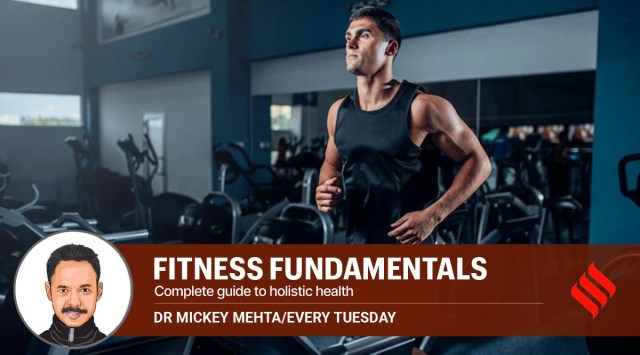How much is too much exercise? What is an ideal and effective routine for each age group?
Exercising by rule should never be a punishment, it should always be a celebration. And a celebratory exercise never takes the body to the point of exhaustion. Exercise should help you liberate energy and not exhaust your energy, says Dr Mickey Mehta
 Exercising by rule should never be a punishment, it should always be a celebration. (Source: Freepik)
Exercising by rule should never be a punishment, it should always be a celebration. (Source: Freepik) Workouts are sometimes stimulation and at most times a calibrated challenge. Why do we need to challenge our body? So that it can grow in its ability, capability, efficiency and functionality. We exercise so that we can remain fit and active in our lifetime. The reason why any exercise routine seems overambitious and tedious is because we look at it from the perspective of achievement rather than as a necessary routine to remain healthy and a must-do to live well.
So first of all, a slow, rhythmic and sub-maximal exercise should be the order of the day. Exercising by rule should never be a punishment, it should always be a celebration. And a celebratory exercise never takes the body to the point of exhaustion. Because if you are exhausted, there is no energy available for the next things to do in life. Exercise should help you liberate energy and not exhaust your energy.
HOW DO YOU DEVELOP YOUR OWN RHYTHM?
The human body is made to adjust to the demands that are made of it. Exercise challenges our bodies, and our bodies respond by growing stronger, more effective and more capable. According to the theory of progressive overload, we must gradually increase the intensity of our workouts if we want to keep progressing and growing. By continually pushing our bodies, we urge them to adapt well to the challenges of the exercises we do. Start slowly, eight to 10 reps at a time maximum, recovering in between, not overdoing to the point of pain and absolute fatigue. Panting is the key. So whenever it comes to a point of discomfort of any kind, whether physical — as in breathing and even mental tiredness — just stop.
Exercising slowly and rhythmically provides several advantages over high-intensity workouts. This method lowers the chance of damage by enabling people to maintain good form and control throughout the session. Additionally, moderate and regulated exercise improves muscle engagement and offers a greater comprehension of the mechanics of the body.
Excess workout can also cause soreness, lactic acid build-up and injuries to knees and joints. In fact, over-exercising may raise your chances of developing joint and cardiac problems. Research has shown the relationship between different exercise volumes and their effect on longevity.
Customise your routine to the demands and abilities of various age groups to attain the greatest health advantages. Following are the age-wise exercise routines for individuals aged between 20 and 30, 30 and 50, 50 and 60, and above 60 years.
EXERCISE INTENSITY ACCORDING TO AGE GROUPS
20-30: Between 20 and 30 years, an individual has the highest physical power and endurance. During this period, developing a strong basis for future health should be the prime focus of an optimum exercise regime. Mix aerobic exercises, including running, cycling or swimming, to increase the fitness of your heart. For the development and maintenance of muscle mass, strength training with weights or bodyweight exercises are essential. Flexibility exercises, such as yoga, can help improve mobility and reduce the risk of injury.
30 to 40: As you move into your 30s and 40s, responsibilities often increase with the demands of work and home life. Finding a balance between exercise and other endeavours is important. An ideal routine should also include aerobic exercises to maintain cardiovascular health. However, it may be necessary to reduce the frequency and intensity somewhat to accommodate other health concerns. Strength training remains essential to prevent age-related muscle decline. Incorporate activities such as brisk walking and stretching during breaks to stay active throughout the day.
50 and above: As you reach the age of 50, joint health becomes a major concern. Low-impact aerobic exercises, such as swimming or cycling, are preferable in this phase because high-impact exercise can overstress joints. Strength training remains essential and focusses on maintaining muscle mass and supporting bone health. As we age, our sense of balance tends to decline, so incorporate balance exercises to reduce your risk of falling. To keep your body flexible, aim for at least 150 minutes of moderate-intensity activity per week, gradually increasing flexibility.
A solemn practice is not only good for your physical health, but also for your mental and emotional health. Engaging in activities that you truly enjoy will increase your motivation and reduce the stress associated with exercise. Ultimately, slow, rhythmic, and sub-maximal exercise offers a pathway to embracing fitness as a lifelong celebration of the body’s potential.
(Dr Mehta has trained Bollywood superstars Akshay Kumar, Preity Zinta, billionaires, politicians, Miss World/Miss Universe candidates and the Maharashtra Police. A best-selling author, his latest book is called ‘Weightless.’ He has been appointed FIT India Movement Champion by the Sports Authority of India)
- 01
- 02
- 03
- 04
- 05































